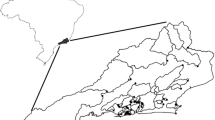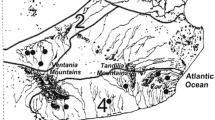Abstract
A model based on theKLS factors of the Universal Soil Loss Equation (USLE) accurately predicted temporal dynamics and relative peak levels of suspended solids, turbidity, and phosphorus in an agricultural watershed with well-protected streambanks and cultivation to the stream edge. Fine suspended solids derived from surface runoff appeared to be a major component of the suspended solids in this stream. The model did not predict the same parameters in a watershed with unstable channel substrates, exposed streambanks, and heterogeneity in riparian vegetation and channel morphology. The rate of increase in concentration of the water quality parameters was higher than predicted in areas without riparian vegetation and with unstable substrates. Peak levels were higher than predicted where unstable channel substrates occurred, and potential energy of the stream was high because of stream alterations (removal of near-stream vegetation and creation of a uniform, straight channel). Timing of the peak levels of suspended solids, turbidity, and phosphorus in these areas seemed related to major flushes of discharge due to delayed inputs from the surface or subsurface or both or to rapid urban drainage. Higher suspended solids concentration in this stream seemed to involve larger quantities of large particles.
Thus, the USLE may not adequately predict relative water quality conditions within a watershed when variation in channel morphology and riparian vegetation exists. We make the following recommendations:
-
1.
Models to predict water quality effects of management programs should combine a terrestrial phase (which details hydrologic and erosion processes associated with surface runoff) with an aquatic phase (which details hydrologic processes of scour and sediment transport in channels). The impact of near-channel areas on these hydrologic processes should receive special attention.
-
2.
Sampling schemes should be designed to account for the impact on water quality of both watershed land surface and inand near-channel processes. In order to help distinguish sources of suspended solids, researchers should emphasize analysis of size distribution of particles transported.
-
3.
Best management systems for improving the broadest range of water resources in agricultural watersheds need to be based on an expanded “critical area” approach, which includes identification of critical erosive and depositional areas in both terrestrial and aquatic environments.
Similar content being viewed by others
Literature cited
American Public Health Association, American Water Works Association and Water Pollution Control Federation. 1976.Standard methods for examination of water and wastewater, 14th ed. Washington, D.C.
Chow, V. T. 1959.Open channel hydraulics. McGraw-Hill Book Co., New York.
Daniel, T. C., P. E. McGuire, G. D. Bibenzer, F. W. Madison, and J. G. Konrad. 1978. Assessing the pollution load from nonpoint sources: planning considerations and a description of an automated water quality monitoring program.Environmental Management 2:55–65.
Dudley, D. R. and J. R. Karr. 1977. Reconciling streambank erosion control with water quality goals. In Lake, J. and J. Morrison (eds.)Environmental impact of land use on water quality: final report on the Black Creek project. Vol. 4. EPA-905/9-77-007D. U.S. Environmental Protection Agency, Chicago, Illinois.
Evans, R. L. and D. G. Schnepper. 1977. Sources of suspended sediment: Spoon River, Illinois. Presented at the North Central Section Geological Society of America, Southern Illinois University.
Grassy, R. G. 1943. Use of turbidity determinations in estimating the suspended solids of streams.Journal of American Water Works Association 34:439–453.
Haith, D. A. and R. C. Loehr, eds. 1979.Effectiveness of soil and water conservation practices for pollution control. Research and Development Series. Environmental Research Laboratory. Athens, Georgia. EPA-600/3-79-106.
Illinois Agricultural Task Force on Nonpoint Sources of Pollution. 1978.Problem assessment report—Soil erosion subcommittee. Mimeographed.
Karr, J. R. and I. J. Schlosser. 1978. Water resources and the land-water interface.Science 201:229–234.
Karr, J. R. and D. R. Dudley. In press. Biological perspective on water quality goals.Environmental Management 5(1).
Lake, J. and J. Morrison, eds. 1977.Environmental impact of land use on water quality: final report on the Black Creek project. Vol. 4. U.S. Environmental Protection Agency, Chicago, Illinois. EPA-905/9-77-007-B.
Leedy, J. B. 1979.Observation on the sources of sediment in Illinois streams. Report No. 18. Illinois Water Information System Group. Urbana, Illinois.
Leytham, K. M. and R. C. Johanson. 1979.Watershed erosion and sediment transport model. Research and Development Series. Environmental Research Laboratory. Athens, Georgia. EPA-600/3-79-028.
Mildner, N. 1976. Streambank erosion in Black Creek watershed, Indiana. Prepared by the USDA Soil Conservation Service. An assignment of the U.S. Task C work group of the International Reference Group on Great Lakes Pollution from Land Use Activities. Mimeographed.
Miller, E. A., T. C. Daniel, and S. J. Berkowitz. 1979. Computer programs for calculating soil loss on a watershed basis.Environmental Management 3:237–270.
Schlosser, I. J. and J. R. Karr. 1980.Determinants of water quality in agricultural watersheds. Office of Water Resources Research Report No. 147. Champaign, Illinois.
Schlosser, I. J. and J. R. Karr. In press. Water quality in agricultural watersheds: impact of riparian vegetation during base flow.Water Resources Bulletin
Soil Conservation Service. 1977. K, T, and T/K values of Illinois soils. Technical Guide section II-A. Mimeographed. Available from Soil Conservation Service, Champaign, Illinois.
Soil Conservation Society of America. 1977.Soil erosion: prediction and control. The Proceedings of a National Conference on Soil Erosion May 24–26, 1976, Purdue University, West Lafayette, Indiana.
Stottenberg, N. L. and J. L. White. 1953. Selective loss of plant nutrient by erosion.Soil Science Society of America Proceedings 17:406–410.
Wischmeier, W. H. 1976. Use and misuse of the universal soil loss equation.Journal of Soil and Water Conservation 20:5–9.
Wischmeier, W. H. and D. D. Smith. 1965.Predicting rainfall-erosion losses from cropland east of the Rocky Mountains. Agric. Handbook No. 282. U.S. Department of Agriculture, Washington, D.C.
Zison, S. W. 1980.Sediment-pollutant relationships in runoff from selected agricultural, suburban, and urban watersheds. U.S. Environmental Protection Agency. Research and Development Series. Environmental Research Laboratory. Athens, Georgia. EPA-600/3-80-022.
Author information
Authors and Affiliations
Rights and permissions
About this article
Cite this article
Schlosser, I.J., Karr, J.R. Riparian vegetation and channel morphology impact on spatial patterns of water quality in agricultural watersheds. Environmental Management 5, 233–243 (1981). https://doi.org/10.1007/BF01873282
Issue Date:
DOI: https://doi.org/10.1007/BF01873282




